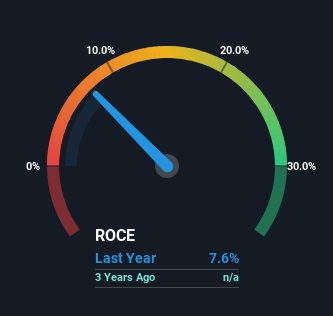Stock Analysis
- United States
- /
- Transportation
- /
- NYSE:RXO
Some Investors May Be Worried About RXO's (NYSE:RXO) Returns On Capital

What underlying fundamental trends can indicate that a company might be in decline? Businesses in decline often have two underlying trends, firstly, a declining return on capital employed (ROCE) and a declining base of capital employed. This reveals that the company isn't compounding shareholder wealth because returns are falling and its net asset base is shrinking. So after we looked into RXO (NYSE:RXO), the trends above didn't look too great.
What Is Return On Capital Employed (ROCE)?
If you haven't worked with ROCE before, it measures the 'return' (pre-tax profit) a company generates from capital employed in its business. Analysts use this formula to calculate it for RXO:
Return on Capital Employed = Earnings Before Interest and Tax (EBIT) ÷ (Total Assets - Current Liabilities)
0.076 = US$92m ÷ (US$1.9b - US$728m) (Based on the trailing twelve months to September 2023).
Thus, RXO has an ROCE of 7.6%. On its own, that's a low figure but it's around the 9.1% average generated by the Transportation industry.
See our latest analysis for RXO

Above you can see how the current ROCE for RXO compares to its prior returns on capital, but there's only so much you can tell from the past. If you're interested, you can view the analysts predictions in our free report on analyst forecasts for the company.
What Does the ROCE Trend For RXO Tell Us?
We are a bit worried about the trend of returns on capital at RXO. To be more specific, the ROCE was 13% two years ago, but since then it has dropped noticeably. On top of that, it's worth noting that the amount of capital employed within the business has remained relatively steady. Since returns are falling and the business has the same amount of assets employed, this can suggest it's a mature business that hasn't had much growth in the last two years. So because these trends aren't typically conducive to creating a multi-bagger, we wouldn't hold our breath on RXO becoming one if things continue as they have.
In Conclusion...
All in all, the lower returns from the same amount of capital employed aren't exactly signs of a compounding machine. Yet despite these concerning fundamentals, the stock has performed strongly with a 9.8% return over the last year, so investors appear very optimistic. In any case, the current underlying trends don't bode well for long term performance so unless they reverse, we'd start looking elsewhere.
RXO does have some risks though, and we've spotted 1 warning sign for RXO that you might be interested in.
While RXO may not currently earn the highest returns, we've compiled a list of companies that currently earn more than 25% return on equity. Check out this free list here.
Valuation is complex, but we're helping make it simple.
Find out whether RXO is potentially over or undervalued by checking out our comprehensive analysis, which includes fair value estimates, risks and warnings, dividends, insider transactions and financial health.
View the Free AnalysisHave feedback on this article? Concerned about the content? Get in touch with us directly. Alternatively, email editorial-team (at) simplywallst.com.
This article by Simply Wall St is general in nature. We provide commentary based on historical data and analyst forecasts only using an unbiased methodology and our articles are not intended to be financial advice. It does not constitute a recommendation to buy or sell any stock, and does not take account of your objectives, or your financial situation. We aim to bring you long-term focused analysis driven by fundamental data. Note that our analysis may not factor in the latest price-sensitive company announcements or qualitative material. Simply Wall St has no position in any stocks mentioned.
About NYSE:RXO
RXO
RXO, Inc. provides full truckload freight transportation brokering services.
Fair value with moderate growth potential.

